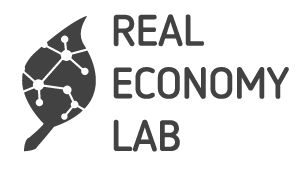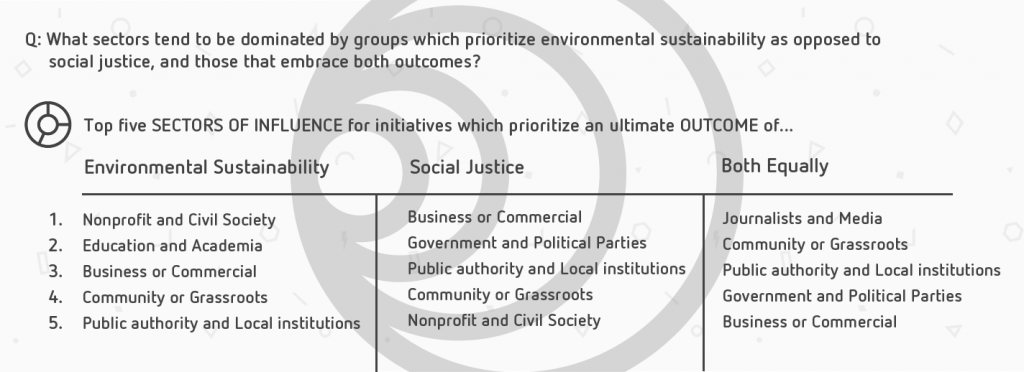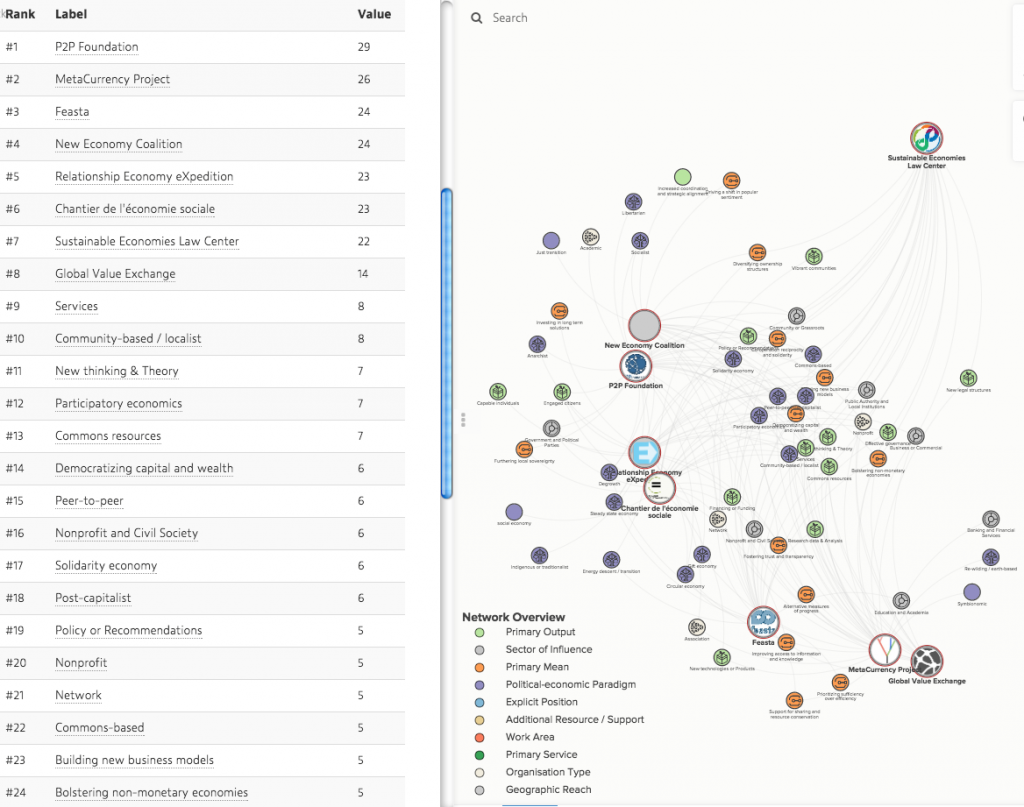30 Jul Sighting Common Ground
Data from Real Economy Lab phase one survey is now available in visual form online at kumu.io and embedded directly in our home page. This data set includes responses from organizations and initiatives working in many areas towards the broadly shared aim of economic systems change. From that baseline consensus – that current systems are not serving our best interest, and substantial change is both feasible and necessary – we are compiling a nuanced graph of intersecting issues, relationships, and ideas to help catalyze collaboration and coalition across the movement. By drawing out a comprehensive view of the ecosystem of initiatives (Actors) in the form of an interactive online map, we are creating context for open and participatory processes designed to uncover common ground, leading to convergent action in the field.
As illustrated in the preceding post, straightforward statistical analysis shows which responses stand out as most frequently selected, providing first order affinity groupings. With a combination of Kumu’s selection, filtering, and focusing features, it’s possible to go a step further and define compound (multi-variable) queries such as: “Which groups that have an environmental focus are working on raising visibility and public awareness of the issues?”
Here are some example questions we are beginning to answer in that way:
The third stage of analysis introduced uses a narrative structure which links several data types or attributes in order to characterize clusters of actors based on their operational context and roles within the system. This leads to concepts like Archetypes, Groups, and Themes as part of a fresh approach to the sort of convergent understanding and collaborative relationships which Real Economy Lab has set out to catalyze. We anticipate that grouping and linking using these high-level ‘meta’ categories could provide stepping stones towards discovery and activation of latent alignments, partnership, and coalitions, while at the same time providing an increasingly integrated view of the ecosystem functioning as a dynamic whole.
Here for example is the process used to identify “Tribe Group” activity clusters via Metamaps and Kumu. Our experimental Tribe Group typology links organizational form, sector, primary output, means / mechanisms, and leading paradigms into a set of 10 broad characterizations based on affinities observed and reported in the field. After the survey data taxonomy was completed in map form, a metamap was created to link specific attributes to each tentative Tribe Group label, which can be viewed here: http://metamaps.cc/maps/1613
Note: the links assigned in this way represent a loose profiling of each Tribe Group based on our understanding of their distinguishing features and habits. It is not definitive or empirical, but rather a first approximation as part of an iterative process to see which correlations are strongest and most meaningful. A more thoroughgoing treatment will be possible in time with a larger data set that provides convincing evidence for these correlations and natural clustering within the ecosystem, plus participant perspectives and feedback as groups come together to explore what ties are most meaningful and practical.
Once we have identified attributes linked with a proposed Tribe Group e.g. “Commons Oriented” shown in the metamap focus view above, it’s a quick step to select those specific attributes from the Kumu map data and then run a metric calculation to find out which actors are most connected to that particular subset. Below is a listing of top results for this Tribe Group cluster, showing top Actors followed by leading attributes they hold in common in the five areas applied to this analysis noted in the above paragraph.
Presumably, members of the same Tribe Group are primed to connect, communicate, and cooperate more readily through recognition of shared identity, territory, and ethos. Members of differing tribe groups might pursue connections and relations by alternative means such as archetypes or themes, or through higher level alliance between Tribes to achieve mutual outcomes. Increasing discernment about the types of inherent ties between actors, showing where there is likely consensus, commonality, or complementarity, could greatly enhance and improve collaborative undertakings and general communication in and around the movement.
What can we tell from this process so far? We’re just beginning to show what’s possible through a layered approach to analysis of this complex terrain. These initial results already form a basis for convergent thought and action in a domain that is notoriously challenging, abstract, and contentious. An emerging map-based visualization of the ecosystem of new economy actors provides a shared view of a complex field in relatively accessible and adaptable form. This is a first step towards locating meaningful common ground. Now anyone can work with this live data set to form and test hypotheses, look for patterns and trends, initiate dialogue, and otherwise explore or analyze the landscape based on their own lines of inquiry.
What will happen when we begin to convene representatives, stakeholders, practitioners, and scholars from active groups and territories around the map with the potential to strike accord, advancing each others’ vision and work in concert? With a better understanding of important features across the landscape as well as key mechanisms, drivers, and trends, we hope to see and to actively facilitate the emergence of an increasingly coherent and inclusive new narrative – and proactive coalition – for changing local and global economies. During the next phase of Real Economy Lab, we’ll work to test and document novel engagements between stakeholders and the resulting outcomes on the way to real, pervasive, economic change.







Pingback:The Real Economy Lab
Posted at 15:20h, 04 March[…] Posted at 13:01h in blog by Benjamin Brownell 0 Comments […]